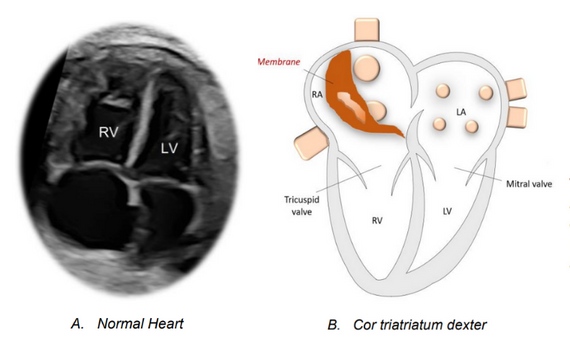This leaflet is to help you understand what COR TRIATRIATUM DEXTER (CTD) is, what causes it, and the implications of being diagnosed for you, your baby, and your family.
What is a CTD?
The normal heart is divided into four chambers, two atria: right and left, and two ventricles: right and left. Blood normally passes from the atria to the ventricles, and then to the lungs and the rest of the body. A CTD occurs when a membrane divides the right atrium into two compartments. This membrane can hinder the passage of blood from the right atrium to the right ventricle.

How does a CTD happen?
There is an alteration in the normal development of the right atrium; the origin of this alteration is unknown. CTD is a rare cardiac anomaly that occurs during intrauterine life (representing less than 0.1%-0.4% of all congenital heart anomalies).
Why is this anomaly is important?
The CTD can be associated with important anomalies in the heart, including a small right ventricle, which can cause severe symptoms in the baby at birth and requires surgery.
If there are no heart defects associated with CTD, it does not imply any major risk to the pregnancy or the baby.
Should I have more tests done?
- It is important to perform a fetal echocardiography - a specialized ultrasound of the baby's heart during pregnancy, which aims to assess whether there is any associated cardiac abnormality.
- Follow-up ultrasounds will be performed during pregnancy to assess the evolution of the pathology.
- There are no known associations between CTD and extracardiac anomalies, genetic syndromes and chromosomal abnormalities. Your caregiver might refer you to genetic counseling, to discuss your options for further genetic investigation.
What are the things to watch for during the pregnancy?
Fetuses with CTD may have associated heart defects that can evolve throughout gestation, so ultrasound monitoring is recommended throughout the pregnancy. The presence of this pathology does not modify the usual obstetric management.
Where should I deliver? Where will the baby receive the best care after it is born?
It will depend on whether there is an associated heart defect with the CTD:
- If no major cardiac anomaly is present, delivery at a tertiary level hospital will not be necessary.
- On the other hand, in the presence of cardiac anomalies such as a hypoplastic right ventricle or pulmonary hypoplasia, delivery should take place in a tertiary hospital to ensure adequate management of the newborn.
What does it mean for my baby after it is born?
If the obstruction in the right atrium is mild, in most cases children are asymptomatic and only require regular follow-up by the pediatric cardiologist.
If the CTD is associated with significant cardiac abnormalities such as hypoplastic right ventricle, the baby may be born and begin with symptoms such as shortness of breath or rapid breathing, bluish skin, lips or nails (cyanosis), difficulty feeding, poor weight gain and fatigue. Heart surgery may be necessary in these children. The pediatric cardiologist or surgeon will explain the most appropriate treatment option for your child.
After surgery, your child will need regular follow-up visits with the cardiologist for the rest of his or her life. Despite surgery, the children may still have heart problems and need treatment. In many cases, children can be active. The level of physical activity will depend on the individual child.
Will it happen again?
As the cause of the CTD is unknown, the risk of recurrence is unknown at this time.
Last updated: June 2022
